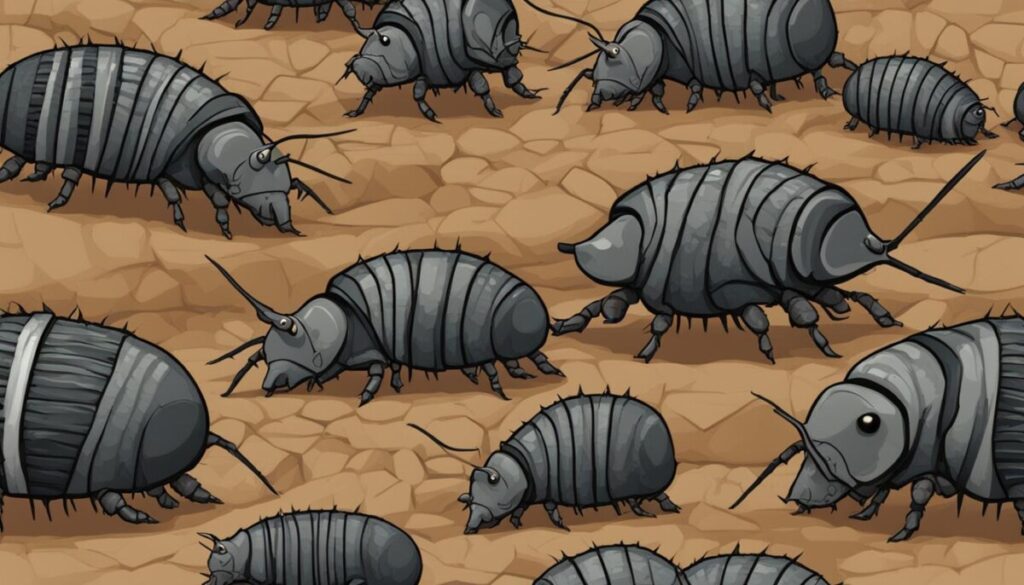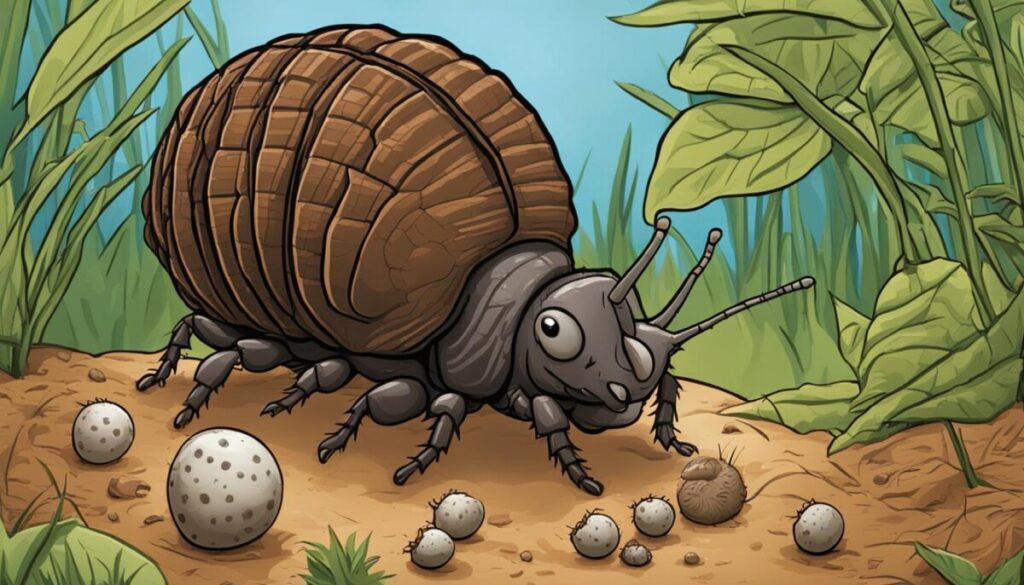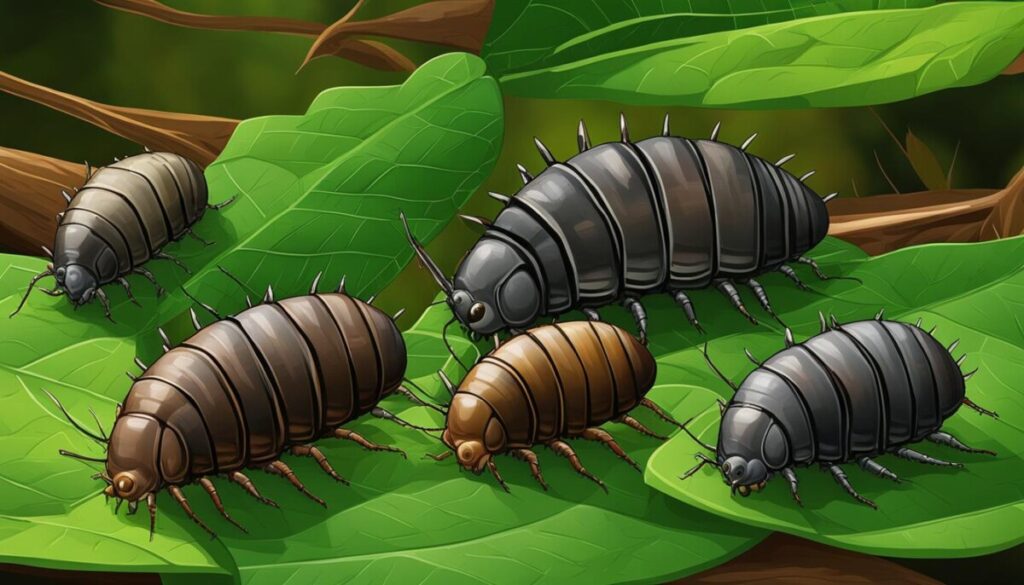Table of Contents
Welcome to the world of pill bugs, also known as rolly pollies! These small creatures are often found in gardens and other moist environments, but did you know that they are actually crustaceans? That’s right, pill bugs belong to the isopod family, which also includes lobsters and shrimp.
While they may be small, pill bugs play an important role in ecosystems as decomposers, helping to break down dead plant matter and contribute to nutrient cycling. Let’s explore more about these fascinating creatures.
Key Takeaways:
- Pill bugs, also known as rolly pollies, are crustaceans belonging to the isopod family
- They are commonly found in gardens and other moist environments
- Pill bugs are important decomposers in ecosystems
- Despite their name, they are not actually bugs or insects
- Understanding their behavior and benefits can help us coexist with these small creatures
What are Pill Bugs?
Pill bugs, also known as roly polies, are small crustaceans that belong to the isopod family. While they are commonly found in gardens, they are not actually insects but are more closely related to lobsters and shrimp.
These fascinating creatures have a unique ability to roll up into a tight ball when threatened, which is where their nickname “rolly polies” comes from. They play an important role in ecosystems as decomposers, helping to break down organic matter.
Despite their important role in nature, pill bugs can become garden pests when populations are large. They may feed on young plants and vegetables, causing damage to gardens and crops.
| Common Name | Scientific Name | Habitat |
|---|---|---|
| Pill bug | Armadillidium vulgare | Moist environments, gardens, forests, under rocks or logs |
| Sowbug | Porcellio scaber | Moist environments, under rocks or logs |
It’s essential to understand the characteristics and behavior of pill bugs to control their populations without harming them or the environment. In the following sections, we will explore these fascinating creatures further and uncover more about their habitat, behavior, and benefits.
Characteristics of Pill Bugs
Pill bugs, also known as roly-polies, are fascinating creatures that belong to the isopod family. They have a unique appearance, with segmented bodies and a hard exoskeleton.
One of the most interesting characteristics of pill bugs is their ability to roll up into a tight ball when threatened. This behavior serves as a defensive mechanism, protecting them from predators.
Pill bugs are not insects; instead, they are more closely related to lobsters and shrimp. They play an important role in ecosystems as decomposers, helping to break down organic matter.
Fun fact: Did you know that pill bugs are also capable of surviving in low-oxygen environments? This adaptation allows them to live in places where other creatures may not be able to survive.

“Pill bugs are fascinating creatures that belong to the isopod family. They have a unique appearance, with segmented bodies and a hard exoskeleton.”
Classification of Pill Bugs
Pill bugs belong to the Armadillidiidae family, which includes sowbugs. They are part of the larger group of isopods, which have around 10,000 known species worldwide.
| Pill Bugs | Sowbugs |
|---|---|
| Can roll up into a tight ball when threatened | Cannot roll up into a ball |
| Breeds by direct development | Breeds by laying eggs in pouches |
| Prefer moist environments | Can live in a wide range of environments |
Pill bugs are more commonly found than sowbugs and are sometimes considered garden pests, although they do not cause significant damage to plants. Both pill bugs and sowbugs play an important role in the ecosystem as decomposers, breaking down organic matter and contributing to nutrient cycling.
Pill Bug Habitat
Pill bugs, also known as isopods, are common garden pests. They prefer to live in moist environments with plenty of decaying organic matter. Gardens, forests, and areas under rocks or logs are all suitable habitats for pill bugs.
These creatures play an important role in the ecosystem as decomposers, breaking down dead plant matter and making nutrients available for other organisms. In fact, they are often found in compost piles, where they contribute to the decomposition process.
Pill bugs are also known to be able to survive in low oxygen environments, making them well adapted to living in the soil. However, their preference for moist environments means that they are more likely to be found in areas where there is regular rainfall or irrigation.
While pill bugs can be beneficial in the garden, they can also become pests if their population becomes too large. In these cases, methods of controlling their population include removing decaying organic matter and using organic pest control solutions.
Pill Bug Behavior
Pill bugs, also known as roly-polies, are fascinating creatures to observe due to their unique behavior. As nocturnal creatures, they are most active at night. During the day, they often hide under rocks, logs, or in other dark and damp environments.
When threatened, pill bugs have a clever defense mechanism. They will curl up into a tight ball, protecting their vulnerable legs and abdomen. This is where their nickname, “rolly-polies,” comes from.
Pill bugs are scavengers, feeding on decaying plant material, detritus, and even small insects. They use their mouthparts to grind up food, as they do not have teeth.
Interestingly, pill bugs are also known for their ability to navigate using the stars. They have been observed using celestial cues to find their way home after being displaced from their natural habitat.
“Pill bugs navigate using celestial cues, which is remarkable for a creature with such a small brain.” – Dr. Ken Catania
Overall, pill bugs are fascinating creatures that are worth observing in their natural habitat. Their unique behavior and interesting adaptations make them an important part of the ecosystem.
Pill Bug Reproduction
Pill bugs, also known as isopods, belong to the Armadillidiidae family and reproduce through a process called “direct development.”
Female pill bugs carry their eggs in a specialized pouch called a marsupium located on their underside. The eggs develop inside the marsupium and hatch into live young, called mancae, which resemble miniature adults.

Pill bugs reach reproductive maturity within a few months and can live for up to three years. They are capable of producing multiple broods throughout their lifespan.
While pill bugs may not be the most glamorous creatures, their unique reproductive process and lifecycle make them an interesting study for scientists and nature enthusiasts alike.
Pill Bug Control: Tips for Removing These Common Garden Pests
If you’ve noticed an infestation of pill bugs in your garden, you may be wondering how to get rid of them without harming other beneficial organisms. Don’t worry – there are several effective methods for pill bug control that can help keep your plants healthy.
Remove Their Preferred Habitat
Pill bugs are attracted to moist environments with plenty of decaying organic matter. To discourage them, keep your garden clean and dry. Rake up leaves and other debris regularly and dispose of them far from the garden. Make sure your garden has good drainage so excess water doesn’t accumulate.
Use Organic Pest Control Solutions
If you have a large infestation of pill bugs, you may need to use pest control solutions to get rid of them. However, it’s important to choose products that are safe for other organisms and the environment. Some effective organic pest control solutions include:
- Diatomaceous earth: This natural substance is made from crushed fossilized algae and can help dehydrate and kill pill bugs.
- Boric acid: A powder that can be used to create bait, which the pill bugs will eat, leading to their demise.
- Traps: You can create traps using materials such as moistened cardboard or potato slices, which will attract and trap pill bugs.
Pill Bug Removal
If you’d prefer not to use pest control solutions, you can also physically remove pill bugs from your garden. Here are some ways to do so:
- Handpicking: This involves manually picking up pill bugs and placing them far from the garden.
- Vacuuming: Use a vacuum cleaner with a hose attachment to suck up pill bugs from garden beds.
- Barriers: You can create barriers around your garden using materials such as copper tape or petroleum jelly to prevent pill bugs from entering.
By using these methods of pill bug control, you can keep your garden healthy and free from these common pests.
Pill Bug Facts: Learn More About Rolly Pollies and Isopods
Pill bugs, also known as rolly pollies, are fascinating creatures that are often misunderstood. In this section, we’ll explore some interesting pill bug facts that will help you appreciate these small crustaceans and their role in the ecosystem.
Pill Bugs and Oxygen
Did you know that pill bugs are capable of surviving in low oxygen environments? They have specialized gills that allow them to extract oxygen from the air, even when it’s scarce. This adaptation is particularly useful for pill bugs that live in damp soil, where oxygen levels may be low.
Pill Bugs and Heavy Metals

Pill bugs have a unique ability to detoxify heavy metals in their body. This means that they can survive in environments that are toxic to other organisms. Scientists are studying the potential use of pill bugs to clean up contaminated soil and water, making them an important subject of research.
Pill Bug Diet
Pill bugs are decomposers and feed on dead plant material, detritus, and even small insects. They can be found in compost piles, under rocks or logs, and in other areas where decaying matter is abundant. As they consume organic matter, they play a crucial role in nutrient cycling and soil health.
Pill Bug Defense Mechanisms
As we mentioned earlier, pill bugs have the unique ability to roll up into a tight ball when threatened. This is a defense mechanism that protects them from predators. They can also release a foul-smelling odor to deter predators from eating them.
Pill Bugs and Sowbugs
Pill bugs belong to the Armadillidiidae family, which also includes sowbugs. While they may look similar, there are some key differences between these two creatures. Sowbugs have a flattened body, while pill bugs are more rounded. Sowbugs are also unable to roll up into a ball like pill bugs can.
Pill Bugs as Pets
Some people choose to keep pill bugs as pets or in educational settings. They are easy to care for and can be housed in a simple setup, such as a plastic container filled with damp soil and decaying matter. If you’re interested in keeping pill bugs as pets, be sure to research their care requirements and provide them with a suitable environment.
As you can see, there is more to pill bugs than meets the eye. These small creatures play an important role in the ecosystem and have some fascinating adaptations that allow them to survive in a variety of environments. Whether you encounter them in your garden or decide to keep them as pets, pill bugs are definitely worth learning more about.
Pill Bug Benefits
Pill bugs, also known as rolly pollies, may be considered garden pests by some, but they actually provide numerous benefits to the ecosystem. As decomposers, they help break down dead plant matter and contribute to nutrient cycling, making them an important part of nutrient-rich soil. Additionally, they serve as a food source for other organisms, including birds and small mammals.
In fact, studies have shown that pill bugs can even help to reduce the impact of heavy metal pollution. Due to their unique ability to detoxify heavy metals, they are able to thrive in contaminated environments and may even aid in the removal of pollutants from soil.
Pill Bugs as Decomposers
Pill bugs play a crucial role in breaking down organic matter, helping to return nutrients to the soil. This process is known as decomposition and is essential for healthy soil and plant growth. Without decomposers like pill bugs, dead plant matter would accumulate, creating a breeding ground for harmful bacteria and fungus.
Pill Bugs as Food Sources
As a food source, pill bugs are particularly important for small mammals and birds, who rely on them as a source of protein. In turn, these larger animals help to spread the pill bugs throughout the ecosystem, allowing them to play an even greater role in nutrient cycling.
Pill Bugs and Heavy Metal Pollution
Heavy metal pollution is a growing concern in many industrialized areas, but pill bugs may be able to help. Studies have found that pill bugs are able to tolerate high levels of heavy metals, such as lead and cadmium, in their environment. In fact, they can even help to reduce the levels of these pollutants in soil over time.
Pill Bugs and Soil Health
By breaking down dead plant matter, pill bugs help to create nutrient-rich soil that is essential for healthy plant growth. This, in turn, benefits the entire ecosystem by providing food and shelter for a wide variety of organisms.
Pill Bugs in Captivity
Many people find pill bugs to be fascinating creatures and choose to keep them as pets or in educational settings. If you are interested in caring for pill bugs in captivity, there are a few things to keep in mind.
Habitat Requirements
Pill bugs require a moist environment, so you will need to create a suitable habitat for them. A plastic container with a lid makes a good enclosure. Line the bottom with a layer of peat moss or coconut coir to help retain moisture. You can also add a piece of bark or a small rock for the pill bugs to climb on.
It’s important to keep the enclosure clean to prevent the buildup of mold or bacteria. Remove any uneaten food or waste regularly and replace the substrate every few weeks.
Feeding
Pill bugs feed on decaying plant matter in the wild, so you can replicate this in captivity by providing them with leaf litter or bits of vegetables such as carrot or lettuce. Make sure to remove any uneaten food to prevent it from rotting in the enclosure. You can also offer small amounts of fish food, which is a good source of protein for pill bugs.
Observing and Handling
Observing pill bugs can be a fun and educational experience. They are primarily nocturnal, so you may need to observe them at night with a flashlight. Be gentle when handling them, as they can be easily injured. You can pick them up by gently cupping them in your hand or using a soft-bristled brush.
Remember that pill bugs are living creatures and require proper care and attention. With the right setup and care, you can enjoy these fascinating isopods in captivity.
Conclusion
As we’ve discovered, pill bugs, also known as rolly pollies, are fascinating creatures that play an important role in our ecosystems. They may be considered garden pests at times, but their benefits far outweigh any negative aspects.
Understanding the behavior and characteristics of these isopods can help us coexist with them in our gardens and other moist environments. Additionally, keeping pill bugs in captivity can be an enjoyable and educational experience.
Appreciating the Little Things
It’s easy to overlook the small creatures that make up our world, but taking the time to learn about them can be incredibly rewarding. Pill bugs may seem insignificant, but they are an essential part of our ecosystem and have some fascinating characteristics.
As we continue to explore and appreciate the world around us, let’s not forget about the little things that make it all possible.
FAQ
Are pill bugs actually insects?
No, pill bugs are not insects. They are crustaceans that belong to the isopod family, which includes lobsters and shrimp.
What is the difference between pill bugs and sowbugs?
Pill bugs and sowbugs are both isopods, but they belong to different families. Pill bugs belong to the Armadillidiidae family, while sowbugs belong to the Porcellionidae family.
Can pill bugs harm my garden?
Pill bugs are generally harmless to gardens, as they primarily feed on decaying plant material. However, in large populations, they can sometimes damage seedlings or young plants.
How do pill bugs protect themselves?
Pill bugs have the ability to roll up into a tight ball when threatened, which provides them with protection from predators.
How do pill bugs reproduce?
Pill bugs reproduce through a process called “direct development.” Females carry their eggs in a specialized pouch and give birth to live young.
Can pill bugs survive underwater?
No, pill bugs cannot survive underwater. They require oxygen and moisture to survive, but they cannot breathe underwater.
Are pill bugs beneficial to the ecosystem?
Yes, pill bugs play a beneficial role in the ecosystem as decomposers. They help break down dead plant matter and contribute to nutrient cycling.
How can I control pill bugs in my garden?
To control pill bugs in your garden, you can remove their preferred habitats, such as decaying organic matter. You can also use organic pest control solutions if necessary.
Can I keep pill bugs as pets?
Yes, some people keep pill bugs as pets or in educational settings. They are low-maintenance and can be housed in a terrarium with appropriate humidity and substrate.
Are pill bugs harmful to humans?
No, pill bugs are not harmful to humans. They do not bite or pose any health risks.

Pingback: Discovering Zebra Isopods
Pingback: Unlocking the Mystery: Benefits of Isopods
Pingback: Explore the Fascinating World of Powder Blue Isopods